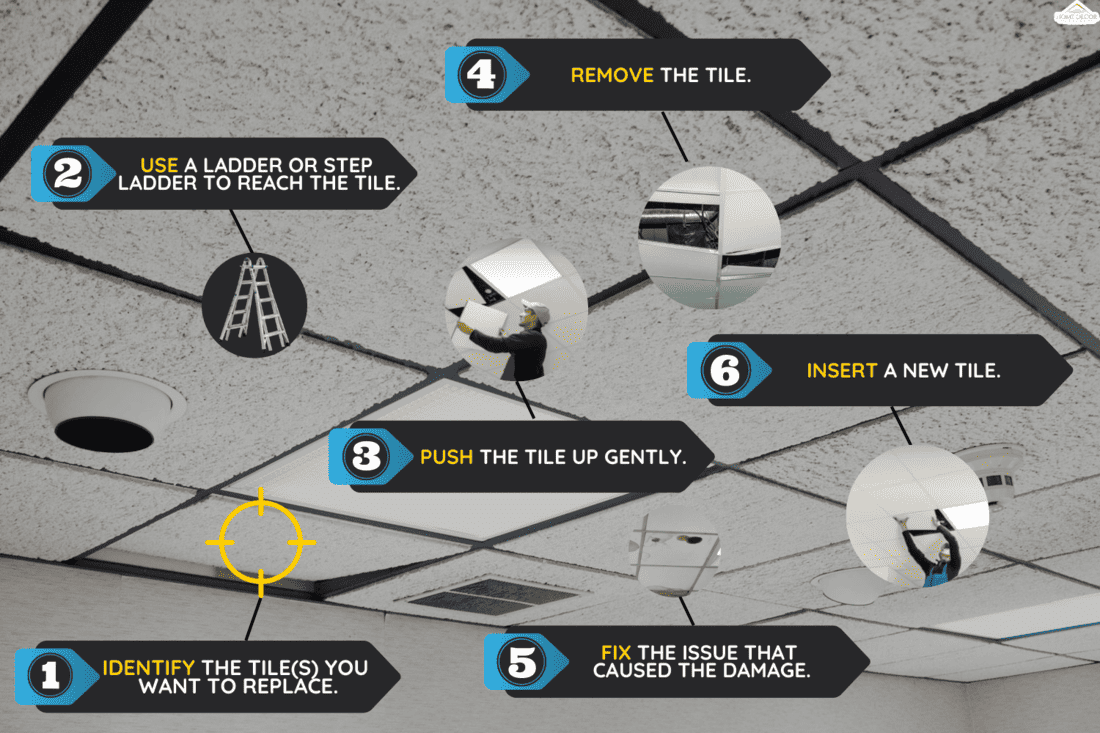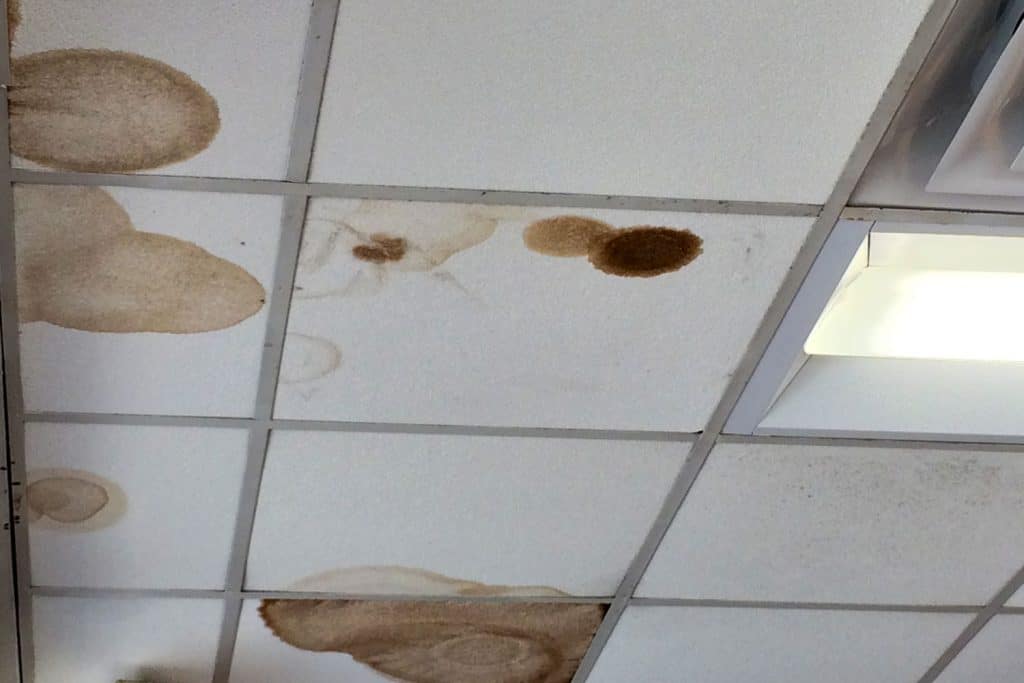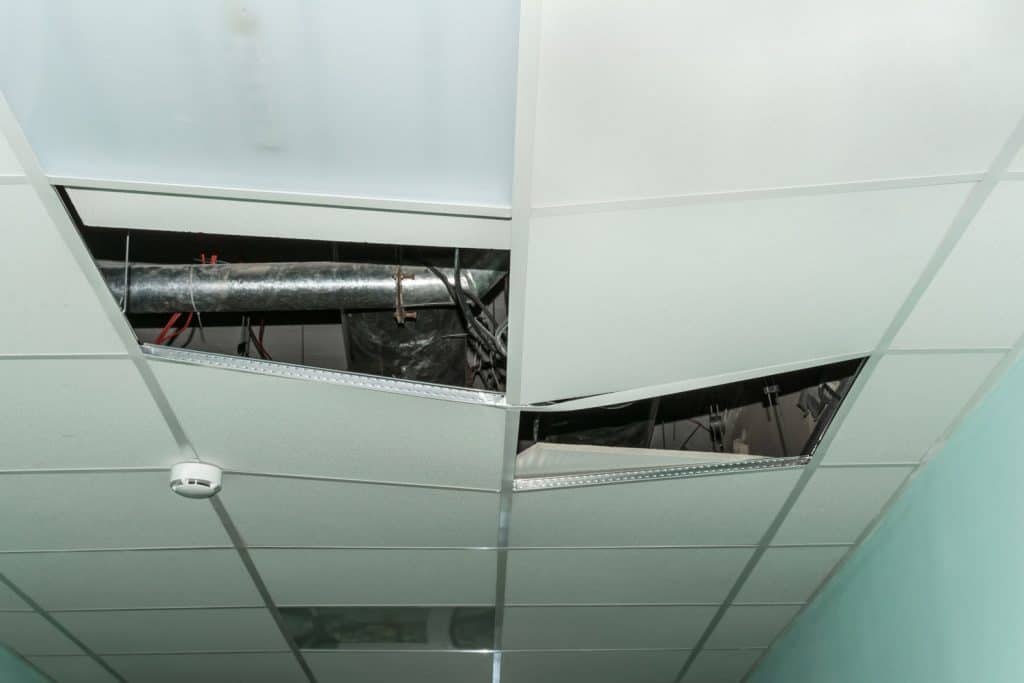Drop ceilings are often found in offices, schools, and sometimes in our homes in an unfinished basement. They cover up wiring, HVAC systems, and other unsightly necessities like plumbing. However, sometimes they become damaged, so you may be wondering how to replace a tile. Well, we've researched in-depth the steps you need to take to replace a tile and have the answer for you.
Replace a drop ceiling by following these steps:
- Identify the tile(s) you want to replace.
- Use a ladder or step ladder to reach the tile.
- Push the tile up gently.
- Remove the tile.
- Fix the issue that caused the damage. (optional)
- Insert a new tile.
Now that we've given you the basic steps to replace a drop ceiling tile keep reading as we elaborate on each one. We'll also answer some other questions you might have about ceiling tiles, including how much they cost, how long they last, and what you can do with the old ones.

Replacing A Drop Ceiling Tile
Drop tiles sometimes need replacing because they are damaged or discolored. Though drop ceilings are a great way to cover up plumbing or HVAC systems, these are often the cause of damaged tiles. Drop ceiling tiles are very susceptible to water damage and can become more unsightly than the objects they are covering.

We sometimes add affiliate links and content that was curated and created by our team with the help of advanced ai tools to help showcase the best design styles.
They may become discolored from secondhand smoke or other heat sources, or if you're renovating your room, they might look old and shabby.
If your tiles aren't damaged, you may be interested in replacing your current ceiling tiles with more aesthetically pleasing tiles. You no longer need to keep that ugly office-looking drop tile. Drop tiles now come in an assortment of designs.
Click here to see Genesis 2ft x 2ft White Icon Relief Ceiling Tiles on Amazon.
Whether your tiles are damaged or you want a new look, the process for replacing them is, fortunately, pretty simple.
Step 1: Identify The Tile/s You Want To Replace

Once you've decided whether to replace a few tiles or the entire ceiling, you'll first need to purchase new ones.
Next, you'll need to identify the tiles you're replacing and place a protective sheet below. This is optional, but replacing drop ceiling tiles can be messy. Placing a sheet or cloth below will protect your carpet or floor from any debris.
Step 2: Use A Ladder Or Step Ladder To Reach The Tile.

If you can't reach the tile comfortably just from standing, you'll need a step ladder or ladder. Place the ladder underneath the tile in a position that will allow you to remove the tile comfortably.
Click here to see Delxo Folding 4 Step Ladder on Amazon.
Step 3: Push The Tile Up Gently

Drop tile ceilings have a grid or frame supporting the tiles. The tiles sit loosely above the grid, resting on the frame. To remove the drop tile, you'll first need to push the tile above the grid.
Step 4: Remove The Tile
Once you've pushed the tile up, rotate it so that you can easily fit it past the frame. Old or damaged drop tiles can crumble, so be careful to avoid snagging the tile on the edges of the frame if you can.
Step 5: Fix The Issue That Caused The Damage (Optional)
We've listed this step as optional because you may be replacing a tile that wasn't caused by a fixable issue. That being said, if your tile was damaged by an issue such as a water leak, it's a good idea to repair the problem, or you'll have to replace the tile again in the future.
Step 6: Replace The Tile
To insert the new tile, reverse the steps you took to remove the old one. Tilt the new tile at an angle so that it easily fits through the grid hole. Rotate it until it lines up with the grid and gently lower it onto the frame.
Put away any equipment you used and clean up any debris, and then you're finished!
If you're more of a visual learner, check out this video tutorial below!
How Much Does It Cost To Replace Drop Ceiling Tiles?
So now you know how to replace drop ceiling tiles, but you may be wondering how much it will cost you. Well, the cost to replace drop ceiling tiles depends on the number of tiles you need to replace, whether you're deciding to replace the entire ceiling and whether you plan to do it yourself. The style of tile you require will also affect the price.
If you're replacing the tiles yourself, drop ceiling tiles range in price from around 60 cents per sq. ft to about $4 per sq. ft. They are relatively inexpensive to buy individually.
If you need to replace the entire drop ceiling, it costs between $5-$28 per sq. ft. for labor and materials.
Some people want to remove the drop ceiling altogether. If you choose to do this, remember that drop ceilings make wiring and plumbing easily accessible. Choosing to replace your drop ceiling with drywall might complicate things in the future.
The national average cost to install a drywall ceiling is around $2 per sq. ft.
How Long Do Ceiling Tiles Last?
You might be surprised to know that ceiling tiles are designed to last around ten years. After ten years, if they haven't been damaged or discolored by some other factor, they may start to become brittle. Older tiles can warp and even break.
Ceiling tiles now come in a variety of materials. Choosing a waterproof tile will likely last you even longer than traditional drop ceiling tiles.
What Can I Do With Old Ceiling Tiles?
You've figured out how to replace your old ceiling tiles, but now you're left wondering what to do with them. Well, you have some options. The first step in determining what to do with your old ceiling tiles is to check for asbestos.
Asbestos ceiling tiles were commonly used up until the 1980s, so if your ceiling was installed after this time, it would not have asbestos tile. If your ceiling tile does have asbestos, you will need to call a professional. Disposing of asbestos tile in your household trash can cause health and safety problems.
If your tile does not contain asbestos, you have a few more options. Depending on what the material is made from, you might be able to recycle your tiles. It's not a bad idea to give the tile manufacturer a call. Sometimes they can recycle your old tiles into new ones.
Another option is to install your new ceiling tiles underneath the old ceiling tiles. This will hide the old ceiling tiles behind your new tiles. There are added benefits to this option—it improves your insulation, and if for any reason you need to return the ceiling to its previous state, you can do so easily.
For more information on how to install new ceiling tiles over old ones, check out this video tutorial:
You can also dispose of ceiling tiles in your trash. Call your city or trash pickup and ask how you should handle disposing of your ceiling tiles. Some cities offer curbside trash pickup, while others might ask you to take them to a landfill. If you're doing a large renovation, consider renting a dumpster.
Final Thoughts
You can see from our steps that replacing drop ceiling tiles is a relatively easy process. Hopefully, our steps will help you replace those old tiles in no time!
Since we're discussing ceilings, maybe you're considering redecorating or renovating other rooms in your house too. If so, check out some of our other blog posts: Should The Ceiling And Walls Be Same Color? or What’s The Standard Ceiling Height? [Answers by House Floor]




